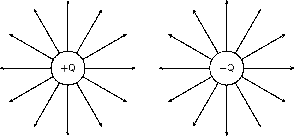| << Chapter < Page | Chapter >> Page > |

Some important points to remember about electric fields:
We will now look at the field of a positive charge and a negative charge placed next to each other. The net resulting field would be theaddition of the fields from each of the charges. To start off with let us sketch the field maps for each of the charges separately.

Notice that a test charge starting off directly between the two would be pushed away from the positive charge and pulled towardsthe negative charge in a straight line. The path it would follow would be a straight line between the charges.

Now let's consider a test charge starting off a bit higher than directly between the charges. If it starts closer to the positivecharge the force it feels from the positive charge is greater, but the negative charge also attracts it, so it would experience a force away fromthe positive charge with a tiny force attracting it towards the negative charge. If it were a bit further from the positive charge theforce from the negative and positive charges change and in fact they would be equal in magnitude if the forces were at equal distances from the charges. After thatpoint the negative charge starts to exert a stronger force on the test charge. This means that the test charge would move towards thenegative charge with only a small force away from the positive charge.

Now we can fill in the other lines quite easily using the same ideas. The resulting field map is:

For the case of two positive charges things look a little different. We can't just turn the arrows around the way we didbefore. In this case the test charge is repelled by both charges. This tells us that a test charge will never cross half way becausethe force of repulsion from both charges will be equal in magnitude.

The field directly between the charges cancels out in the middle. The force has equal magnitude and opposite direction. Interestingthings happen when we look at test charges that are not on a line directly between the two.

We know that a charge the same distance below the middle will experience a force along a reflected line, because the problem issymmetric (i.e. if we flipped vertically it would look the same). This is also true in the horizontal direction. So we use this factto easily draw in the next four lines.

Working through a number of possible starting points for the test charge we can show the electric field map to be:

We can use the fact that the direction of the force is reversed for a test charge if you change the sign of the charge that isinfluencing it. If we change to the case where both charges are negative we get the following result:

Notification Switch
Would you like to follow the 'Siyavula textbooks: grade 11 physical science' conversation and receive update notifications?